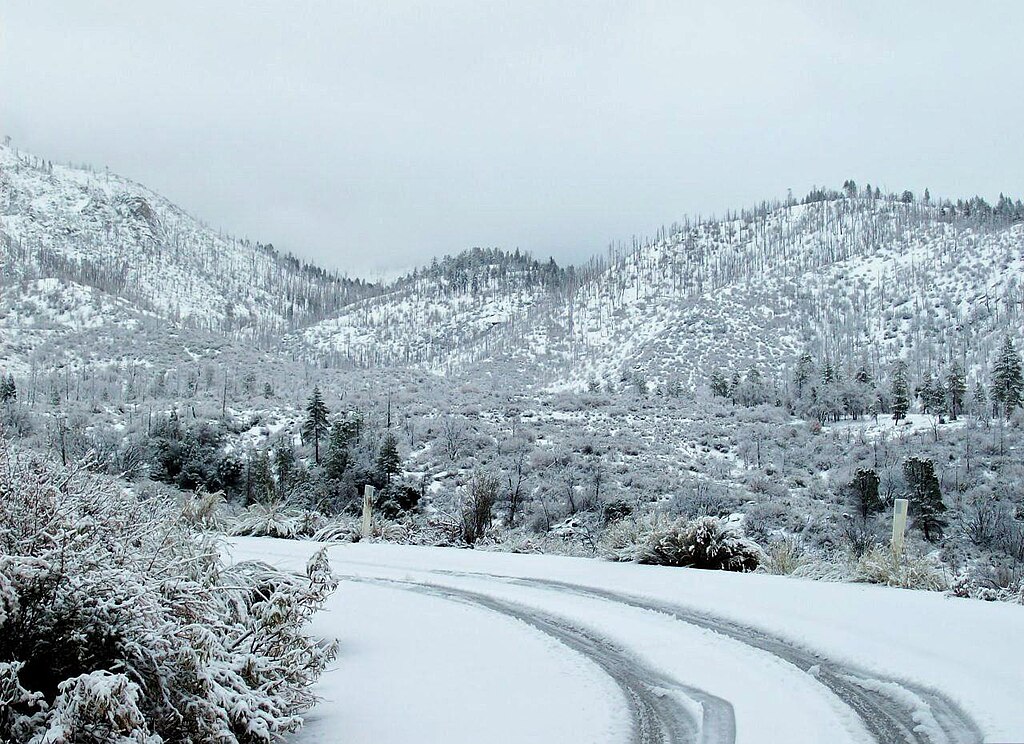Snow
หิมะ เป็นรูปหนึ่งของการตกลงมาของน้ำจากบรรยากาศ อยู่ในรูปของผลึกน้ำแข็งจำนวนมากเรียก เกล็ดหิมะ จับตัวรวมกันเป็นก้อน ดังนั้นหิมะจึงมีเนื้อที่หยาบเป็นเกล็ด และมีโครงสร้างที่กลวงจึงมีความนุ่มเมื่อสัมผัส
หิมะนั้นเกิดจากละอองน้ำเกิดการเกาะรวมตัวกันในชั้นบรรยากาศที่อุณหภูมิต่ำว่า 0 °C (32 °F) และตกลงมา นอกจากนี้หิมะยังสามารถผลิตได้จากเครื่องสร้างหิมะเทียม (snow cannon)
รูปลักษณะของเกล็ดหิมะ
คำอธิบายถึงความสมมาตรของเกล็ดหิมะนั้นโดยทั่วไป มีอยู่ 2 คำอธิบาย คือความสมมาตรของส่วนที่ยื่นออกมาของเกล็ดหิมะนั้น จะเป็นสมมาตรแบบหกด้านเสมอ เนื่องมาจากเกล็ดน้ำแข็งปกตินั้นมีโครงสร้างผลึกหกเหลี่ยม (หรือที่รู้จักกันในชื่อ ice Ih) บนระนาบฐาน (basal plane)
- อาจเป็นไปได้ที่จะมีการสื่อสารหรือแลกเปลี่ยนข้อมูลระหว่างส่วนที่ยื่นออกของเกล็ดหิมะ ซึ่งส่งผลให้การงอกออกของแต่ละก้านนั้นส่งผลถึงกัน ตัวอย่างของรูปแบบที่ใช้ในการสื่อสารนั้นอาจเป็น ความตึงผิว หรือ โฟนอน (phonon)
- คำอธิบายที่สองนี้จะค่อนข้างแพร่หลายกว่า คือ แต่ละก้านของเกล็ดหิมะนั้นจะงอกออกโดยไม่ขึ้นแก่กัน ในสภาพแวดล้อมที่อุณหภูมิ ความชื้น และสภาพแวดล้อมอื่น ๆ นั้นมีการเปลี่ยนแปลงอย่างรวดเร็ว แต่เมื่อเทียบกับขนาดของเกล็ดหิมะแล้วเชื่อว่าสภาพแวดล้อมจะมีสภาพที่เหมือนกันในช่วงขนาดสเกลของเกล็ดหิมะ ซึ่งส่งผลให้การงอกออกของก้านในแต่ละด้านนั้นอยู่ภายใต้เงื่อนไขเหมือนกัน จึงทำให้ลักษณะการงอกออกนั้นเหมือนกัน ในลักษณะเดียวกับที่รูปแบบการเติบโตของวงแหวนอายุในแกนของต้นไม้ในสภาพแวดล้อมเดียวกันจะมีรูปร่างเหมือน ๆ กัน ความแตกต่างของสภาพแวดล้อมที่ระดับสเกลใหญ่กว่าเกล็ดหิมะนั้นส่งผลให้รูปของเกล็ดหิมะแต่ละเกล็ดนั้นมีรูปร่างที่แตกต่างกัน และหิมะเกิดจากการละอองน้ำในอากาศที่แปรสภาพเป็นของแข็งเพราะอุณหภูมิต่ำ
อย่างไรก็ตาม แนวความคิดที่ไม่มีเกล็ดหิมะใดที่มีรูปร่างเหมือนกันนั้นไม่ถูกต้อง เกล็ดหิมะสองเกล็ดนั้นมีโอกาสเหมือนกันได้ เพียงแต่โอกาสนั้นน้อยมาก American Meteorological Societyได้บันทึกการค้นพบเกล็ดหิมะที่มีรูปร่างเหมือนกันโดย แนนซี่ ไนท์ (Nancy Knight) ซึ่งทำงานที่National Center for Atmospheric Research ผลึกที่ค้นพบนั้นไม่เชิงเป็นเกล็ดหิมะซะทีเดียวที่เป็นรูป ปริซึมหกเหลี่ยมกลวง (hollow hexagonal pris )
"Snowfall" redirects here. For other uses, see Snow (disambiguation) and Snowfall (disambiguation).
 |
The process of precipitating snow is called snowfall. Snowfall tends to form within regions of upward movement of air around a type of low-pressure system known as anextratropical cyclone. Snow can fall poleward of these systems' associated warm fronts and within their comma head precipitation patterns (called such due to the comma-like shape of the cloud and precipitation pattern around the poleward and west sides of extratropical cyclones). Where relatively warm water bodies are present, for example because of water evaporation from lakes, lake-effect snowfall becomes a concern downwind of the warm lakes within the cold cyclonic flow around the backside of extratropical cyclones. Lake-effect snowfall can be heavy locally. Thundersnow is possible within a cyclone's comma head and within lake effect precipitation bands. In mountainous areas, heavy snow is possible where upslope flow is maximized within windward sides of the terrain at elevation, if the atmosphere is cold enough. Snowfall amount and its related liquid equivalent precipitation amount are measured using a variety of different rain gauges.Snow is precipitation in the form of flakes of crystalline water ice that falls from clouds. Since snow is composed of small ice particles, it is a granular material. It has an open and therefore soft, white, and fluffy structure, unless subjected to external pressure. Snowflakes come in a variety of sizes and shapes. Types that fall in the form of a ball due to melting and refreezing, rather than a flake, are known as hail, ice pellets or snow grains.
ไม่มีความคิดเห็น:
แสดงความคิดเห็น